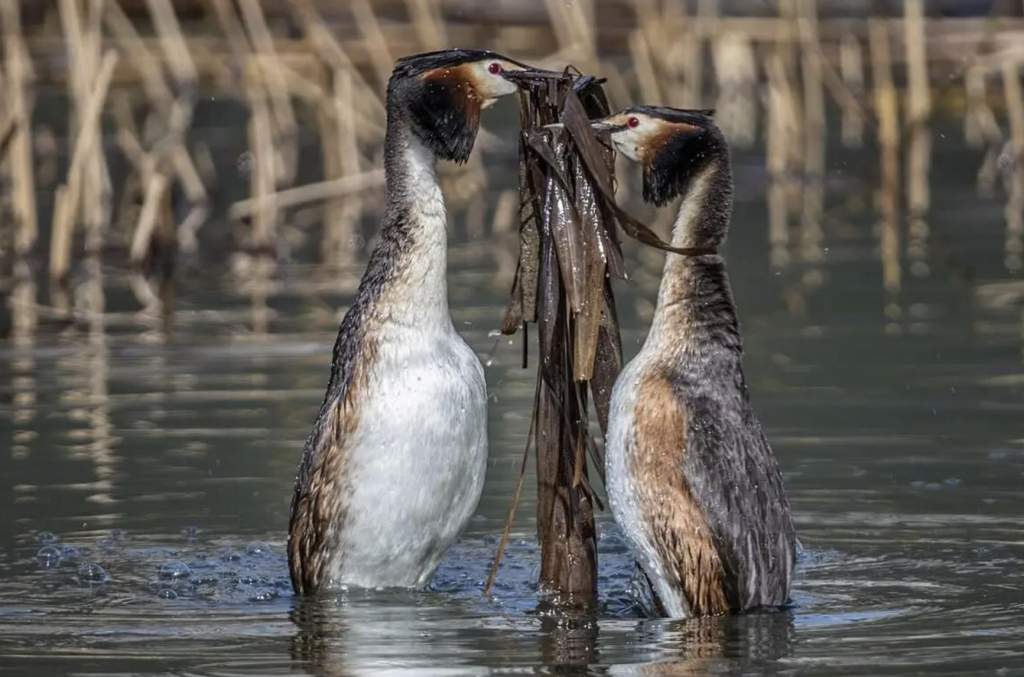The Great Crested Grebe (Podiceps cristatus) is a striking water bird known for its elaborate courtship displays and elegant appearance.
Behavior and Habitat: The great crested grebe is an aquatic bird adept at diving and flying little, except when migrating. With paddle-shaped toes set far back on their bodies, they sit low in the water. like the other grebes, with slender, erect necks. At rest, the head is sunk on the shoulders, and the bill is often buried in feathers on one side. The silky, white underparts are displayed during preening as the bird rolls onto its side.
The Great Crested Grebe, with its double-horned crest and chestnut frills about the head, has an elaborate courtship display. The most common display involves ‘head-shaking’ as head feathers are raised. In the ‘discovery ceremony’ one bird makes a far-carrying two-note call, while another bird spreads its wings and face ruff partly. They approach each other in a shallow underwater ‘ripple dive’, then rise beyond it in a ‘ghostly penguin’ display. They shake their heads together and turn away. This is followed by a “weed trick” and “weed dance” with the birds diving and bringing up weeds, approaching each other, and rising breast to breast nearly upright as they stretch their necks. They sway, paddle with their feet, and sink again.
Grebes build floating nests in sites that vary from reed beds growing in a few feet of briny or brackish as well as freshwater by the shoreline to islands of weeds floating in deep water. The territories around the nest are strongly defended. Both sexes construct the nest out of water weeds, rushes, and reeds, attached to emergent plants, and both incubate for three to four weeks. Weeds are pulled over the eggs when the incubating bird leaves the nest. After the young hatch, they ride on the backs of one parent while the other brings food for them to eat.

Diet: Like other grebes, the Great Crested Grebe dives for its food, staying underwater for nearly a minute but usually for shorter periods. It can swim considerable distances underwater, moving both feet at once, and usually swallows its food there. Its diet includes fish, insects and larvae, crustaceans, snails, tadpoles, plant material, and quantities of feathers. Fish figure prominently, and these it secures by rapid pursuit.
Identification: Both sexes are similar. Although dark brown above, silky white below, the flanks are mottled with brown and dark grey. The crest on each side of the crown is black, and the cheeks and throat are white. Feathers of the side of the head elongated into a pair of tippets, or ruffs, chestnut near the base, and shading to black at the tips. Wings have two white patches, one on the secondaries and one on the leading edge of the forearm.
Eyes are red. The bill is brown above and carmine below. Lobed feet are dark olive above, pale yellow below. Distinct non-breeding areas have shortened tippets, reduced crests, and browner crowns. The immature birds have some stripes on their heads and remain in juvenile plumage. Flying as young as adults but lacking tippets and crests. The downy young is sooty brown above with white stripes on the head, neck, and back. The bare pink spot on the crown turns red when young birds are excited.
Vocalizations: Great Crested Grebe calls are thought to be similar to those of the European birds: loud, rattling, rather shrill trumpeting bark in threat; too-note advertising call row-ah; ticking note during head-shaking displays; copulation note; and begging calls by chicks.
Nesting: Usually breeds in November–March. Nest a mat of water plants, often in loose colonies.
Eggs and Incubation: Great Crested Grebe lay 3 to 7 eggs; pale green dulled with stain; oblong-oval, about 55 x 35 mm. Incubation is 22–29 days, for both sexes. Both sexes feed the young, carried on the back of one of the parents. Periodically, there is a changeover. The parent carrying the brood rises and flaps its wings. The young tumble into the water, swim to the other parent, and clamber aboard, using the parent’s foot as a ramp.
Alternative Names: This bird is known as Crested Grebe, Tippet Grebe, Australasian crested grebe and, in the Māori language, pūteketeke
Size: Great Crested Grebe size is about 500 mm.
Distribution: On open sheets of water, mostly in east and southwestern Australia, vagrants are occasionally seen inland, particularly in the Lake Eyre basin and Murray-Darling drainage. One race in Australia-New Zealand. Elsewhere, it is widespread in temperate parts of Eurasia and southern Africa. The Great Crested Grebe nests on a raft of water plants, moored to reeds to prevent it from drifting away.
Races: There are three races recognized:
- c. australis (Gould, 1844): Found in Australia, South Island of New Zealand.
- c. cristatus (Linnaeus, 1758): Eurasia
- c. infuscatus (Salvadori, 1884): Africa
Family: Podicipedidae

Read More: Ladder-backed Woodpecker






